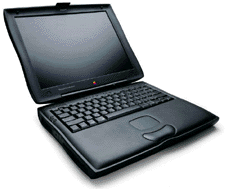Announced in March 1998, The PowerBook G3 Series was
an entirely new design, which resembled its predecessor only
in name. The G3 Series was the first Built-to-Order
Powerbook line, and filled Apple's PowerBook offerings,
from low to high end, with a single motherboard design. The
G3 Series was available with a variety of  BTO options
including a 233, 250 or
292 Mhz PPC750
processor (The 250
and 292 Mhz models
had a bus speed of 83
Mhz, and came with
512k L2 Caches
running at a 2:1 ratio.
The 233 Mhz model
had no L2 Cache and
had a system bus speed of 66 Mhz.), and either a 12"
passive-matrix screen, a 13.3" TFT Active Matrix screen, or
an incredible 14.1" TFT Active Matrix Screen (Both TFT
screens were capable of true 24-bit color at 1024x768,
while the 12" screen was 16-bit at 832x640). All models
included two RAM slots which used industry standard RAM
modules (the same used in most IBM Thinkpads), hardware
2D and 3D Graphics acceleration, and ADB, VGA, SCSI,
serial, sound input and output, 4Mbps IrDA, and 10B-T
Ethernet ports. The G3 Series had a large, redesigned
keyboard which included a new Function button allowing the
keyboard to take on the functionality of a full size 105-key
keyboard. It had 2 PC-card slots, which were CardBus
compliant (a powerbook first), and the 13.3" and 14.1"
models included an S-Video output. The G3 Series had two
drive bays, either of which could hold a battery or a wide
array of 3.5" expansion devices, such as floppy or zip
modules. The right drive bay could also accommodate larger
5.25" devices, such as the standard 24x CD-ROM drive (A
DVD-ROM drive was also available). The PowerBook G3
Series started at $2,299 for 233 Mhz with no floppy drive
and a 12" screen, and cost around $7,000 fully loaded.
Picture: Apple Corporate Site
BTO options
including a 233, 250 or
292 Mhz PPC750
processor (The 250
and 292 Mhz models
had a bus speed of 83
Mhz, and came with
512k L2 Caches
running at a 2:1 ratio.
The 233 Mhz model
had no L2 Cache and
had a system bus speed of 66 Mhz.), and either a 12"
passive-matrix screen, a 13.3" TFT Active Matrix screen, or
an incredible 14.1" TFT Active Matrix Screen (Both TFT
screens were capable of true 24-bit color at 1024x768,
while the 12" screen was 16-bit at 832x640). All models
included two RAM slots which used industry standard RAM
modules (the same used in most IBM Thinkpads), hardware
2D and 3D Graphics acceleration, and ADB, VGA, SCSI,
serial, sound input and output, 4Mbps IrDA, and 10B-T
Ethernet ports. The G3 Series had a large, redesigned
keyboard which included a new Function button allowing the
keyboard to take on the functionality of a full size 105-key
keyboard. It had 2 PC-card slots, which were CardBus
compliant (a powerbook first), and the 13.3" and 14.1"
models included an S-Video output. The G3 Series had two
drive bays, either of which could hold a battery or a wide
array of 3.5" expansion devices, such as floppy or zip
modules. The right drive bay could also accommodate larger
5.25" devices, such as the standard 24x CD-ROM drive (A
DVD-ROM drive was also available). The PowerBook G3
Series started at $2,299 for 233 Mhz with no floppy drive
and a 12" screen, and cost around $7,000 fully loaded.
Picture: Apple Corporate Site